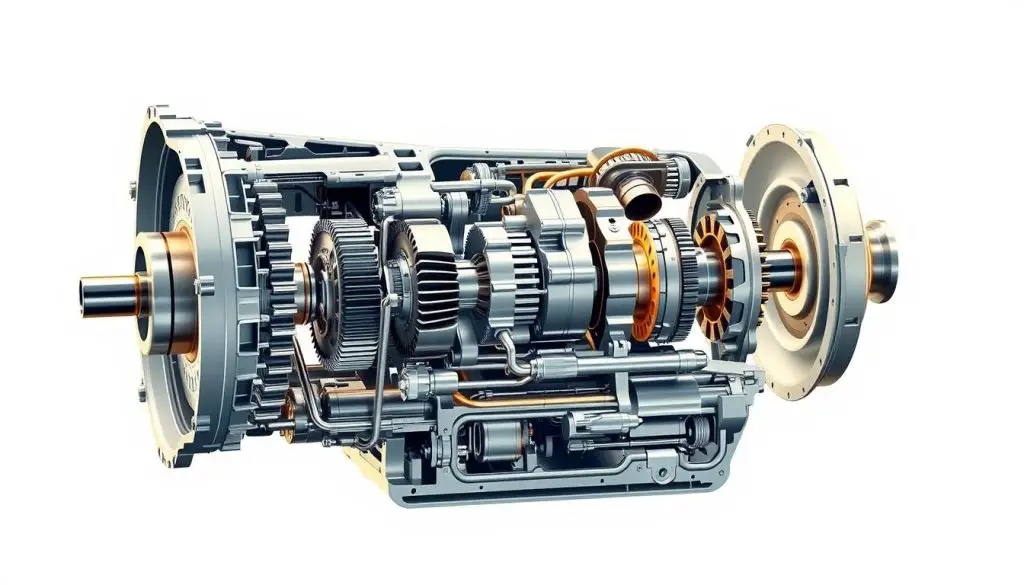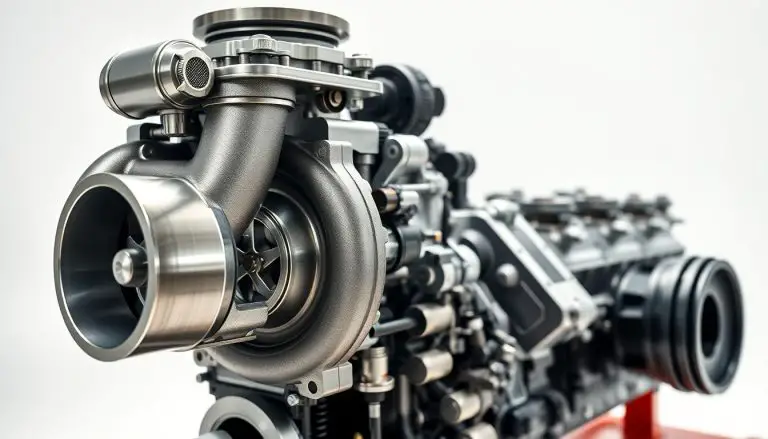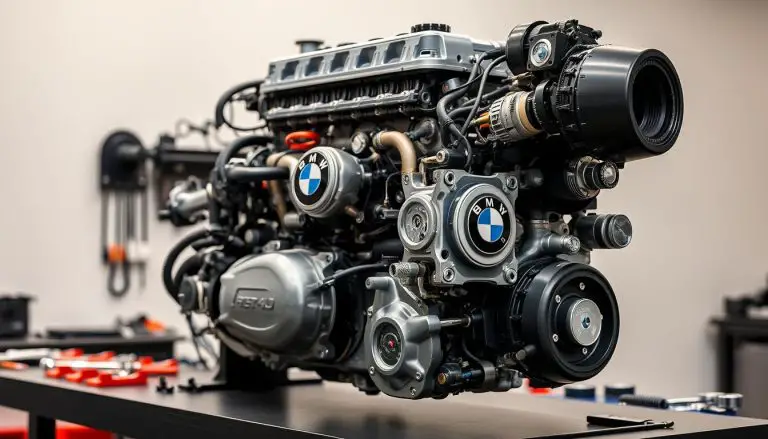The ZF8HP transmission, integral to numerous automotive models, is not immune to malfunctions. Such issues can significantly impair its functionality. It is imperative for both vehicle proprietors and technicians to comprehend prevalent transmission problems. This understanding is vital for effective diagnosis and rectification.
This discourse aims to elucidate common afflictions of the ZF8HP transmission and offer guidance on troubleshooting and repair methodologies. By pinpointing the underlying cause of malfunctions, one can undertake corrective measures. This approach is essential to avert further deterioration.
Key Takeaways
- Common issues affecting the ZF8HP transmission
- Troubleshooting steps for diagnosis
- Repair options to fix transmission problems
- Importance of regular maintenance
- Consequences of neglecting transmission issues
Understanding the ZF8HP Transmission
The ZF8HP transmission, an 8-speed automatic designed for longitudinal engine configurations, epitomizes smooth shifting and efficiency. Its widespread adoption in various vehicle models underscores its performance and reliability, making it a critical component in the automotive industry.
What is the ZF8HP Transmission?
Engineered to optimize gear ratios across a broad spectrum of driving scenarios, the ZF8HP transmission enhances both fuel efficiency and vehicle performance. Its advanced design facilitates seamless gear transitions, resulting in a more refined driving experience.
Common Vehicle Models Using ZF8HP
Manufacturers such as BMW, Chrysler, and Jeep have integrated the ZF8HP transmission into their models. The BMW 5 Series, Chrysler 300, and Jeep Grand Cherokee are among the vehicles that benefit from this transmission. Recognizing these models aids in pinpointing common issues and streamlining troubleshooting efforts.
Technical Specifications and Design
The ZF8HP transmission boasts an 8-speed design, a longitudinal engine configuration, and an advanced hydraulic control system. Its compact architecture enables efficient integration into diverse vehicle platforms, showcasing the transmission’s versatility and adaptability.
| Specification | Description |
|---|---|
| Transmission Type | 8-Speed Automatic |
| Engine Configuration | Longitudinal |
| Control System | Advanced Hydraulic |
| Design Architecture | Compact |

Common ZF8HP Transmission Problems
Vehicle owners with the ZF8HP transmission may encounter several common issues necessitating attention. Grasping these problems is vital for preserving the transmission’s performance and longevity.
Shifting Issues and Hesitation
Shifting issues, often manifesting as hesitation or rough shifting, are prevalent with the ZF8HP transmission. These problems frequently stem from low fluid levels or faulty solenoids. Regular fluid level checks can preemptively identify potential issues.
Fluid Leaks and Contamination
Fluid leaks are another common issue, potentially leading to contamination within the transmission. Such contamination can cause malfunction, necessitating costly repairs. Prompt identification and addressing of leaks is crucial.

Torque Converter Problems
The torque converter is a critical component of the ZF8HP transmission. Issues with the torque converter can result in slipping or vibration, impacting the vehicle’s performance. Regular maintenance can help mitigate these problems.
Electrical and Solenoid Failures
Electrical and solenoid failures can disrupt the transmission’s operation, leading to symptoms such as erratic shifting or failure to engage gears. Diagnosing these issues requires specialized equipment and expertise.
| Common Problem | Symptoms | Potential Cause |
|---|---|---|
| Shifting Issues | Hesitation, rough shifting | Low fluid levels, faulty solenoids |
| Fluid Leaks | Fluid contamination, transmission malfunction | Leaks in transmission system |
| Torque Converter Problems | Slipping, vibration | Torque converter failure |
| Electrical/Solenoid Failures | Erratic shifting, failure to engage gears | Electrical or solenoid component failure |
By understanding these common ZF8HP transmission problems, vehicle owners can proactively maintain their transmission’s health and address issues before they escalate.
Warning Signs of ZF8HP Transmission Failure
Timely identification of ZF8HP transmission failure warning signs is imperative. Recognizing these indicators is crucial for averting further damage and the resultant costly repairs.
Unusual Noises and Vibrations
The initial manifestation of ZF8HP transmission malfunctions often includes unusual noises and vibrations. Grinding, whining, or clunking sounds frequently signify worn-out or damaged transmission components.
Delayed or Harsh Shifting
Delayed or harsh shifting is a prevalent issue. It can stem from low transmission fluid levels, contaminated fluid, or malfunctions in the transmission’s electronic controls. For a comprehensive exploration of ZF8HP transmission problems and their resolutions, refer to this resource.
Transmission Warning Lights
Modern vehicles are equipped with transmission warning lights that illuminate upon detecting a problem. These lights are integral to the vehicle’s onboard diagnostics system, which continuously monitors the transmission’s performance.
Fluid Condition Indicators
Assessing the transmission fluid condition is paramount. Fluid appearing dark or having a burnt smell indicates contamination or degradation, signaling potential transmission issues. Regular ZF8HP transmission maintenance, including fluid checks, is essential for early problem identification.
Diagnostic Tools and Procedures
The process of troubleshooting the ZF8HP transmission necessitates a variety of diagnostic tools and procedures. These tools are instrumental in identifying problems with precision and efficiency.
OBD-II Scanner Usage
An OBD-II scanner emerges as a pivotal tool for diagnosing ZF8HP transmission malfunctions. It extracts trouble codes from the vehicle’s onboard computer, offering crucial insights into the problem’s nature. Through the analysis of these codes, technicians can pinpoint the underlying cause of the issue.
Transmission Fluid Inspection
Transmission fluid inspection stands as a fundamental diagnostic procedure. The fluid’s condition and level can indicate contamination, degradation, or leaks. Technicians scrutinize the fluid’s color, consistency, and level to assess its functionality.
Pressure Testing Methods
Pressure testing serves to uncover leaks or blockages within the transmission. By applying pressure to specific transmission points, technicians can detect anomalies in the system. This technique is instrumental in diagnosing issues that may evade detection through other methods.
Professional Diagnostic Equipment
Utilizing professional diagnostic equipment, such as transmission testers, offers profound insights into the transmission’s state. These specialized tools measure parameters like pressure, temperature, and flow rate, enabling technicians to diagnose intricate problems with accuracy.
| Diagnostic Tool | Purpose | Benefits |
|---|---|---|
| OBD-II Scanner | Retrieve trouble codes | Identifies root cause of issues |
| Transmission Fluid Inspection | Check fluid condition and level | Reveals signs of contamination or degradation |
| Pressure Testing | Identify leaks or blockages | Diagnoses issues not apparent through other means |
| Professional Diagnostic Equipment | Measure transmission parameters | Provides detailed insights into transmission condition |
Step-by-Step Troubleshooting Guide
Addressing ZF8HP transmission malfunctions necessitates a methodical strategy to pinpoint and rectify problems expeditiously. This guide delineates the essential steps to diagnose and potentially rectify issues with your ZF8HP transmission.
Initial Assessment Process
The initial phase entails collecting data regarding the symptoms manifesting with your ZF8HP transmission. This encompasses documenting any aberrant noises, vibrations, or performance anomalies. It is imperative to scrutinize any trouble codes via an OBD-II scanner, as these can offer crucial insights into the malady.
- Note the symptoms: slipping, hesitation, or unusual noises
- Check for trouble codes using an OBD-II scanner
- Review the vehicle’s maintenance history
Checking Transmission Fluid Levels
Verifying the transmission fluid level is a pivotal step in troubleshooting ZF8HP transmission malfunctions. Deficient fluid levels can precipitate a plethora of issues, including slipping, hesitation, and impaired gear engagement. Ensure the fluid level is at the manufacturer’s recommended level, and replenish it if necessary.
Important: Always consult your vehicle’s service manual for the precise methodology to inspect transmission fluid levels.
Testing Electronic Components
Examining electronic components, such as solenoids and sensors, is crucial to identify any electrical anomalies that might be impeding your ZF8HP transmission’s functionality. Employ a multimeter to assess the resistance and voltage of these components, adhering to the manufacturer’s specifications.
Mechanical Inspection Procedures
A mechanical inspection entails scrutinizing for signs of wear or damage on components like the torque converter and clutch packs. Investigate for indicators of excessive wear, overheating, or contamination, which can signify the root cause of the problem.
Tip: Regular maintenance can avert numerous mechanical maladies. Adhere to your vehicle’s maintenance schedule to ensure compliance.
By adhering to this step-by-step troubleshooting guide, you can efficaciously diagnose and potentially rectify issues with your ZF8HP transmission. Remember, if any aspect of the process eludes your comprehension, it is advisable to seek the counsel of a professional mechanic.
DIY Repair Options for ZF8HP Transmissions
The ZF8HP transmission, renowned for its intricate design, can be serviced and repaired through various DIY methodologies. This approach not only reduces labor expenses but also enhances vehicle owners’ comprehension of their transmission’s inner workings.
Fluid and Filter Replacement
Replacing the transmission fluid and filter constitutes one of the most straightforward and impactful DIY maintenance endeavors for the ZF8HP transmission. Fresh fluid and a new filter can notably enhance transmission performance and extend its lifespan. It is imperative to utilize the transmission fluid type recommended by the manufacturer.
Solenoid Replacement Guide
Malfunctioning solenoids can precipitate shifting malfunctions and other transmission-related issues. The replacement of solenoids necessitates a profound understanding of the transmission’s electrical framework and the capability to identify malfunctioning solenoids. This task demands patience and the utilization of appropriate tools.
Valve Body Servicing
The valve body, a pivotal component of the ZF8HP transmission, regulates fluid flow and pressure. Servicing the valve body entails cleaning and inspecting its components. While it can be a DIY-friendly endeavor, it necessitates meticulous attention to detail to ensure proper execution.
When to Avoid DIY Repairs
While DIY repairs can be economically advantageous, there are instances where professional intervention is advisable. Complex repairs, such as those involving the transmission’s internal components or requiring specialized tools, are best entrusted to professionals. Further, if you are uncertain about the diagnosis or the repair process, seeking professional assistance can avert further transmission damage to your vehicle.
Preventative Maintenance for ZF8HP Transmissions
Ensuring the longevity of your ZF8HP transmission necessitates a proactive maintenance regimen. By implementing regular maintenance protocols, one can effectively circumvent common malfunctions and enhance transmission functionality.
Recommended Fluid Change Intervals
The maintenance of your ZF8HP transmission hinges on the observance of recommended fluid change intervals. The manufacturer’s guidelines typically advocate for fluid replacement every 30,000 to 60,000 miles. Yet, this interval may fluctuate based on the driving environment and the vehicle’s specific characteristics. For a comprehensive exploration of ZF8HP transmission-related issues and their resolutions, refer to this resource.
Driving Habits That Extend Transmission Life
Adopting specific driving practices can significantly influence the lifespan of your ZF8HP transmission. It is advisable to steer clear of extreme temperatures, aggressive driving maneuvers, and excessive towing loads. Smooth acceleration and braking practices also contribute to the transmission’s longevity.
Regular Inspection Checklist
Implementing a comprehensive inspection regimen is imperative for early detection of potential issues. This entails verifying transmission fluid levels, scrutinizing for signs of leaks, and examining the transmission pan and filter. Regular inspections facilitate the identification of problems before they escalate into major malfunctions.
Software Updates and Technical Service Bulletins
Adherence to software updates and technical service bulletins is equally critical. These updates are designed to rectify known issues and elevate transmission performance. It is imperative to consult with your dealership or a reputable mechanic to ascertain the availability of updates for your ZF8HP transmission.
Conclusion
The imperative to comprehend and rectify ZF8HP transmission malfunctions is paramount for the longevity of your vehicle’s transmission. The identification of warning signs, such as anomalous noises, delayed gear shifts, and illuminated transmission warning lights, enables the initiation of preventive measures against the financial burden of ZF8HP transmission repairs.
Adherence to a regimen of regular maintenance, encompassing fluid exchanges and inspections, is indispensable for the preservation of your ZF8HP transmission’s functionality. The utilization of the troubleshooting guide and DIY repair methodologies presented within this discourse can facilitate the resolution of prevalent issues. In instances where complexities arise, the engagement of a proficient mechanic is recommended to guarantee the efficacy of ZF8HP transmission repair.
Through the cultivation of knowledge and the adoption of proactive strategies, one can effectively mitigate ZF8HP transmission malfunctions, thus ensuring the continued seamless operation of your vehicle’s transmission for an extended period.
FAQ
What are the most common problems associated with the ZF8HP transmission?
Issues frequently encountered include malfunctions in shifting, fluid leaks, failures of the torque converter, and malfunctions of electrical or solenoid components.
How do I know if my ZF8HP transmission is failing?
Indicators of failure include unusual noises, vibrations, delayed or harsh shifting, illumination of transmission warning lights, and suboptimal fluid condition.
Can I diagnose ZF8HP transmission problems myself?
Affirmative, self-diagnosis is feasible through the utilization of an OBD-II scanner, visual inspection of transmission fluid, and execution of pressure tests.
What is the recommended maintenance schedule for the ZF8HP transmission?
Adherence to a maintenance regimen, encompassing regular fluid changes, typically every 30,000 to 60,000 miles, alongside periodic inspections, is crucial for transmission longevity.
Can I repair my ZF8HP transmission myself?
Simple undertakings such as fluid and filter replacement are amenable to DIY execution. In contrast, intricate repairs necessitating intervention of the torque converter or valve body may necessitate professional expertise.
How do driving habits affect the ZF8HP transmission’s lifespan?
Practices such as avoidance of extreme temperatures, moderation in driving aggressiveness, and minimization of heavy towing contribute to the transmission’s longevity.
Are software updates important for the ZF8HP transmission?
Affirmative, software updates and adherence to technical service bulletins are imperative for resolving known issues and enhancing transmission performance.
What are the benefits of regular transmission inspections?
Proactive inspections facilitate early identification of potential issues, thus mitigating the likelihood of costly repairs and extending the transmission’s operational lifespan.
Can a faulty solenoid cause transmission problems?
Affirmative, a malfunctioning solenoid can disrupt the transmission’s functionality, manifesting as symptoms such as shifting malfunctions or slipping.
How does the ZF8HP transmission’s design impact its performance?
The transmission’s 8-speed configuration and longitudinal engine layout are optimized for efficiency and seamless shifting, enhancing overall performance.


